Manufacturing Executives: Keep Up With Technology or Get Left Behind

Technology has advanced more in the last thirty years than in the previous two thousand. The exponential increase in advancement will only continue.
If Bohr had any idea how true his statement would become, we think even he would be astounded today. Amazingly, Mr. Bohr delivered that quote going on 100 years ago.
Technology affects almost every business decision on the shop floor and in the office. Whether you are trying to improve customer service, manage a global supply chain, or are trying to increase visibility in your company, technology is a key driver of collecting, analyzing, and reporting information and operating a business.
Today’s latest buzzwords, the Industrial Internet of Things (IIoT), combined with powerful analytics can bring far greater speed and clarity to operational decision-making in order to boost productivity, innovation, and service. What will tomorrow bring?
The importance of keeping up with technology can mean the difference between really winning big, as compared to running an average business, or even losing. There is no one formula that will put you in touch with the latest advancements in technology; however, we’ve listed four suggestions below that may aid you, as an executive in the manufacturing industry, on your journey to keep up with technology:
- Observe others: Whenever you can, check out your competitors, or even talk to friends and acquaintances in your industry. Have a mindset geared toward learning how others use technology to drive success. If you find something new that you may not understand, talk to those in the know to find out more. As an owner or a key executive, you are responsible for helping your organization leverage success with technology.
- Escape your comfort zone: Successful leaders get out of their comfort zone and keep in touch with their “learning zone.” The learning zone is where you push the boundaries of your existing knowledge and skills. The benefits of technology should make good business sense. Have an awareness about what is working and what isn’t. If you aren’t tech savvy, check to see how others have found benefit before taking the next step.
- Ask questions: Observe your internal operations and ask people how their current technologies are working. Don’t settle for things that people think you want to hear. Ask them to be honest and openly tell you what is working as well as what isn’t. Make lists of what you hear throughout the organization. ERP systems, for example, should allow your organization to function like a well conducted orchestra. If the tune you are hearing isn’t the sweet sound of music, find out why.
- Get an assessment: If you don’t know what you don’t know, get someone to assess your business to find out what you’re missing. Too often, ERP systems go off the rails for amazingly crazy reasons. For instance, the reason your people are using your system in an unproductive way could be because the person who was in charge wanted to do it that way… but that person left the company two years ago and he wanted the new system to work like the old system.
The search for optimum operational performance will never really end. With that said, when you have well tested and efficient processes in place, they should help you scale for years. ERP systems, like an orchestra, are very interdependent. They rely on one another and should integrate well from one department to another. In fact, information from one area to another should flow effortlessly, allowing downstream functions to become more and more simple. For years, firms have toiled with ways to improve their organizations ability to streamline the internal processes of the business. Successful leaders need to continue to look to the technology that surrounds them.
The Lake Companies has worked for the past 34 years to deliver smart technology to manufacturing companies that helps make their organizations more productive, efficient, easier to manage, and profitable. Ask us how we can help your business find greater success by leveraging the power of evolving technology.


Comments are closed.